This Dutch oven beef stew recipe holds a special place in my heart, and I can't wait to share it with you! It's incredibly easy to make, yet bursting with flavour. Imagine serving this hearty stew with fluffy potato gnocchi and a cold glass of beer – your guests will be asking for seconds (and the recipe!).
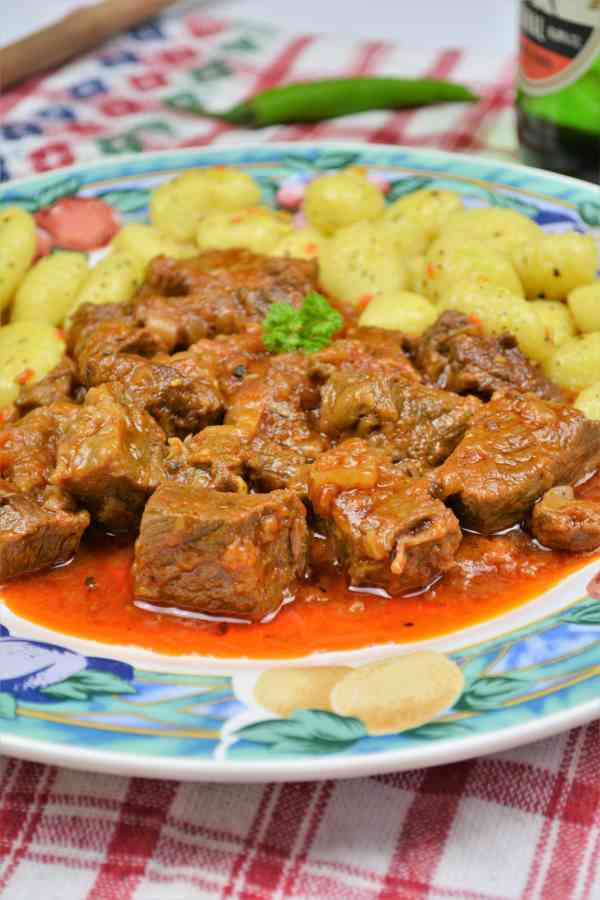
Jump to:
Like many of my recipes, this one has Hungarian influences, particularly in the use of paprika and marjoram. These spices add a wonderful depth of flavour like in my Hungarian beef paprikash, that I highly recommend. This simple recipe uses just a few ingredients alongside the beef, which is slow-cooked until incredibly tender and flavourful.
Ingredients
This recipe is perfect for two hungry adults or three with smaller appetites. Simply double or triple the ingredients to serve more people.
In this recipe I will use:
- 500 g Beef: I recommend using a chuck roast for this recipe. It's a flavourful and affordable cut that becomes meltingly tender when slow-cooked. Cut the beef into 1-inch cubes for optimal browning and even cooking.
- One Onion: Onions are essential for building flavour in this stew. Their sweetness balances the richness of the beef and the spices. Yellow or white onions work best.
- One Yellow Pepper: Adds a touch of sweetness and a vibrant colour to the stew. Feel free to substitute with another colour bell pepper or omit it if you don't have one on hand.
- Two Cloves of Garlic: Garlic adds a pungent and savoury note to the stew. Use fresh garlic cloves for the best flavour.
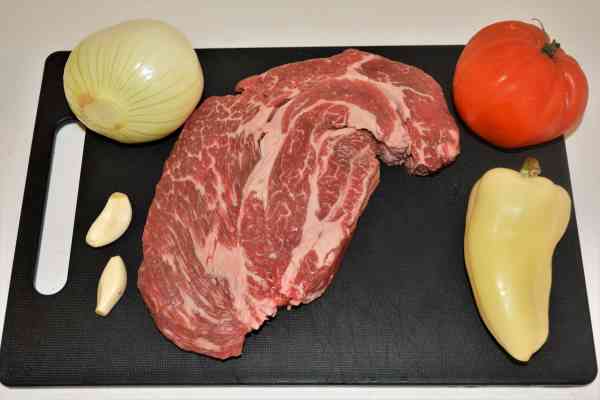
To make the stew as delicious as possible, I will also use:
- 1 tablespoon Flour: A light dusting of flour helps to create a beautiful crust on the beef when seared. It also thickens the stew as it simmers. All-purpose flour works well, but you can also use a gluten-free blend if needed.
- 2 tablespoon Pork Lard: Lard adds richness and depth of flavour to the stew. You can substitute with vegetable oil or butter if you prefer, but lard provides a more authentic taste.
- One Tomato: Tomato adds richness and depth of flavour to the stew. You can substitute with crushed tomatoes or tomato puree if needed.
- 100 ml Red Wine: Red wine adds another layer of complexity and depth to the stew. Choose a dry red wine like Cabernet Sauvignon or Merlot.
- 1 tablespoon Paprika: This spice adds a beautiful red colour and a warm, slightly sweet flavour to the stew. Use sweet paprika for a milder flavour or hot paprika for a bit of a kick.
- 2 teaspoon Marjoram: Marjoram adds a unique earthy and slightly citrusy flavour to the stew. It pairs well with the other spices and complements the beef.
- Salt and Pepper: Essential seasonings to enhance the flavours of all the ingredients in the stew.
In this beef stew, the meat takes center stage. I've chosen to exclude other vegetables, such as carrots, to truly highlight the beef's rich and savoury character.
Why Use Braising Steak Instead of Diced Beef?
The key to a truly delicious Dutch oven beef stew starts with the meat. Instead of pre-cubed beef, I suggest buying a larger cut of chuck roast and cutting it into cubes yourself. This way, you can select a piece with good marbling, like the braising steak I used.
The thin streaks of fat throughout the braising steak, like in my homemade beef stroganoff, will melt during the long cooking process, creating a richer, more flavourful stew. Pre-cubbed meat is often leaner and may come from less desirable parts of the animal.
How to Prepare the Ingredients For the Beef Stew?
Let's start by gathering all our ingredients. For this stew, I've chosen a well-marbled braising steak. I'll cut it into cubes, making sure to leave the fat on. As the stew simmers, this fat will melt, enriching the sauce and creating melt-in-your-mouth tenderness.
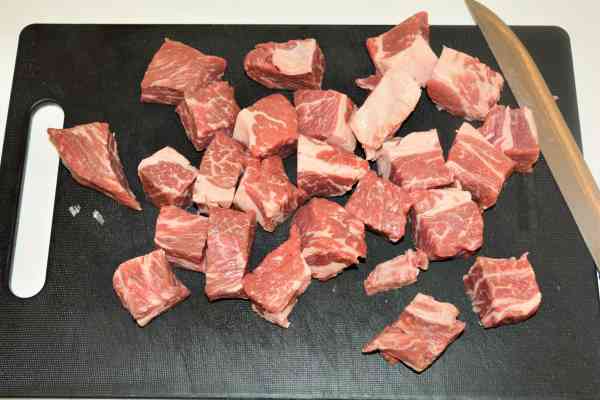
First, I finely chopped the onion so it would practically melt into the stew, contributing its flavour without being noticeable.
The garlic I minced (though crushing it is a good alternative), and the bell pepper I diced into small pieces to ensure even cooking alongside the onion.
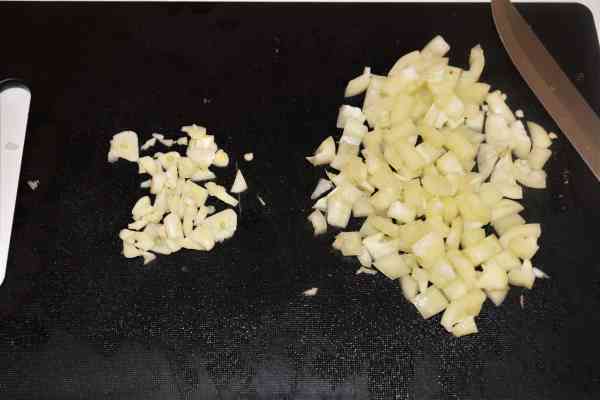
There are a few ways to prepare the tomato for this stew. You can cube it, peel it and chop it, or use my preferred method: halving the tomato and grating it, leaving only the peel behind.
How to Make the Dutch Oven Beef Stew Recipe?
Frying the Meat
Searing the beef creates a delicious crust and adds depth of flavor to the stew. I heated two tablespoons of pork lard in my Dutch oven and then browned the meat in batches.
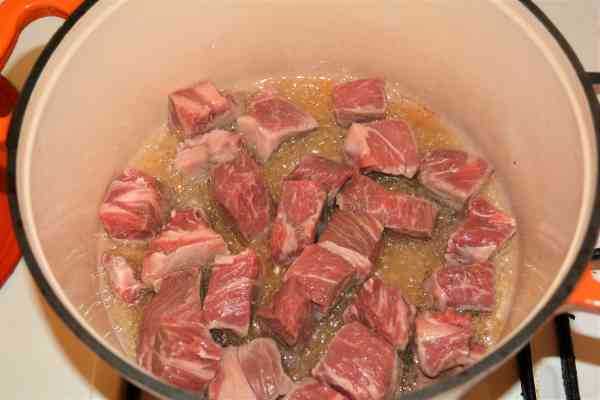
I seared the beef until it developed a rich, golden-brown crust, about 2-3 minutes per side. The seared beef was then set aside.
Continue With the Vegetables
Once the beef is removed, add another tablespoon of pork lard to the Dutch oven. (You can substitute with goose fat or two tablespoons of oil.) Now it's time to sauté the vegetables.
Add the finely chopped onion, garlic, and bell pepper to the pot and cook over medium heat until the onion is translucent. The key here is to soften the vegetables, not to crisp them.
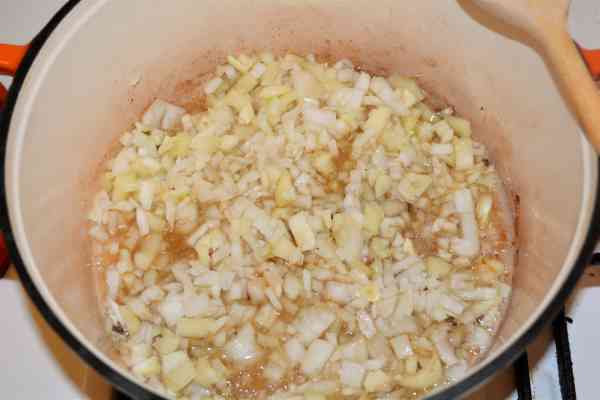
Sauté the onion, garlic, and pepper for 2-3 minutes over medium heat until softened. Then, add the seared beef back to the pot.
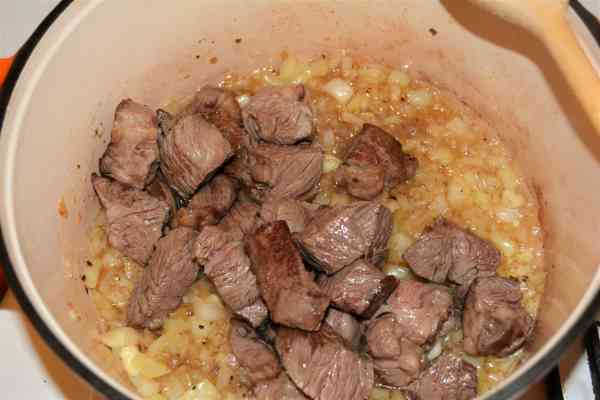
Seasoning the Stew
To season the stew, I'm adding 1 teaspoon of sea salt, 1 teaspoon of freshly ground black pepper, 1 tablespoon of Hungarian paprika (sweet paprika is a good substitute), 1 bay leaf, and 2 teaspoons of dried marjoram.
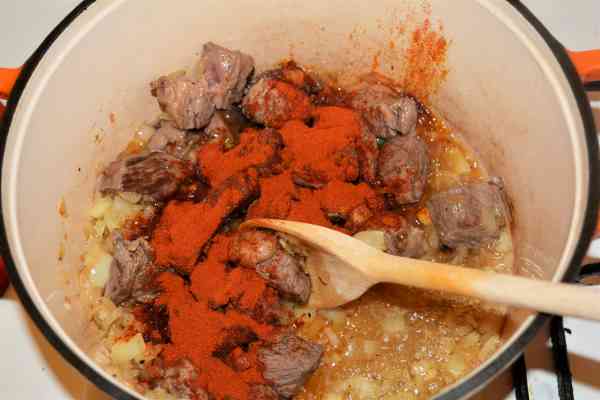
Finishing the Dish
Quickly stir the paprika into the stew to prevent it from burning, then add the grated tomato. Pour in about 100 ml red wine, half a liter of water and stir to combine.
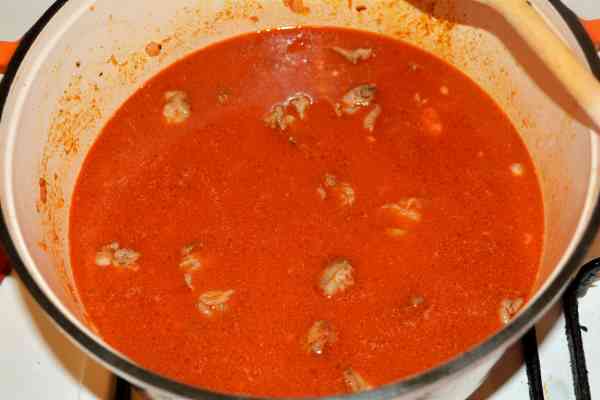
Simmer the stew, covered, over low heat until the beef is fork-tender. This will likely take around 1 ½ hours, but the exact time will vary depending on the cut and quality of the beef. Be sure to check the meat periodically to ensure it's cooked to your liking.
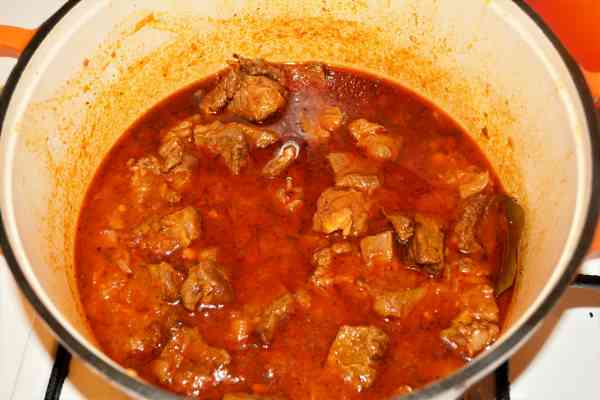
And that's all there is to it! Our easy Dutch oven beef stew is finished and ready to serve. I'm so excited for you to try it!
Variations
Dutch oven beef stew is wonderfully adaptable. Here are some variations you can try:
- Root Vegetables: Add carrots, parsnips, or potatoes (or a combination). Cut them into bite-sized pieces and add them to the stew about 30-45 minutes before it's finished cooking, as they'll need less time than the beef.
- Mushrooms: Add sliced mushrooms (cremini, shiitake, or your favorites) towards the end of cooking (about 15-20 minutes before serving) so they don't become mushy.
- Celery: Include chopped celery stalks along with the onion, garlic, and bell pepper for added flavour.
- Green Beans or Peas: Stir in fresh or frozen green beans or peas during the last 10-15 minutes of cooking for a pop of colour and freshness.
Serving the Stew
The Dutch oven beef stew can be served in different ways, and I chose the delicious potato gnocchi I bought and just boiled them. But it also goes well with mashed potatoes, polenta, French fries or dumplings. And with hot chilly pepper and a glass of cold beer is the ideal dinner for me.
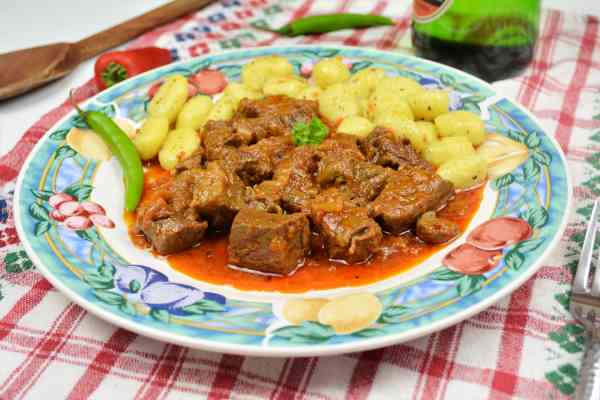
How to Store?
Allow the stew to cool to room temperature before refrigerating. This prevents condensation from forming and affecting the stew's quality. Don't leave it at room temperature for more than two hours.
Transfer the Dutch oven beef stew to an airtight container. Glass or plastic containers work well. If you made a large batch, you might need to divide it into smaller containers for easier storage and faster cooling/reheating.
Store the covered container(s) in the refrigerator. Beef stew will generally keep for 3-4 days in the fridge.
FAQ
There's no single answer, as it depends on several factors, but here's a breakdown to help you estimate:
- Most common cuts (chuck, brisket, short ribs): For these cuts, you're typically looking at 1.5 to 3 hours of simmering time, sometimes even longer. It's best to start checking for tenderness around the 1.5-hour mark.
- Other cuts: If you're using a different cut, start checking for tenderness earlier, perhaps after an hour.
Dutch ovens are fantastic for stews for a few key reasons:
- Even Heat Distribution: Dutch ovens, especially those made of cast iron, excel at distributing heat evenly. This is crucial for stewing because it prevents hot spots and ensures the beef cooks uniformly, resulting in tender, evenly cooked pieces.
- Heat Retention: Once a Dutch oven gets hot, it holds that heat incredibly well. This consistent temperature is essential for the long, slow simmering that makes stew so delicious.
- One-Pot Wonder: Because you can sear and then stew in the same pot, clean-up is a breeze. This one-pot approach also helps to build flavour, as all the delicious browned bits from searing the meat stay in the pot and contribute to the richness of the stew.
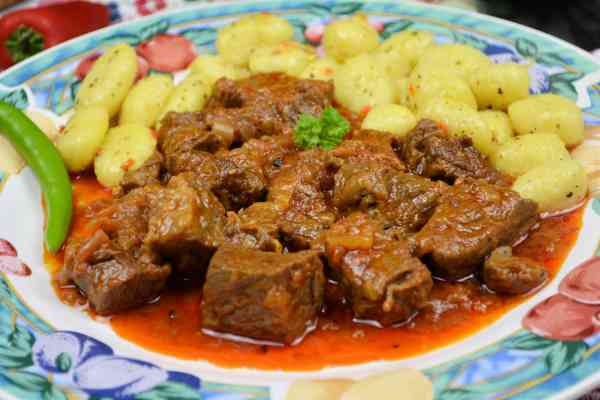
Let us know what you think of this Dutch oven beef stew in the comments below! We'd love for you to like and share it on Facebook, Twitter, Instagram and Pinterest. Subscribe to stay updated on our latest recipes.
Related
If you liked my cast iron Dutch oven beef stew recipe, I also recommend other various stew recipes from our blog, such as:
Best Dutch Oven Beef Stew-With Hungarian Flavours
Equipment
- 1 Dutch oven pot
Ingredients
- 500 g beef braising steak
- 1 pc onion large size
- 1 pc tomato ripe
- 1 pc yellow paprika pepper
- 2 cloves garlic
- 3 tablespoon sunflower oil
- 2 tablespoon pork lard or goose lard
- 1 tablespoon sweet paprika powder Hungarian
- 1 teaspoon sea salt kosher
- 1 teaspoon ground pepper freshly ground
- 1 piece bay leave fresh or dried
- 2 teaspoon marjoram dried
- 100 ml red wine
- 500 ml water
Instructions
- Take this beef braising steak and cut it into cubes, peel the onion and then chop it finely, cut the pepper and the garlic cloves into small pieces.
- Cut the tomato in half and then grated it with the cut side until only the peel that I threw remained.
- Melt two tablespoons of pork lard in a Dutch oven and then put the pieces of meat to fry. Fry the meat for 2-3 minutes until it got a copper colour, turning them on each side, then take them out on a plate.
- In the same Dutch oven add three tablespoons of oil and put the onion, garlic and pepper to fry over medium heat.
- Sauté it for about two or three minutes on medium heat and then put the pieces of pre-fried meat back in the pot.
- Season with sea salt, freshly ground pepper, paprika (if possible Hungarian), bay leaf and dried marjoram, add the grated tomato after which pour the red wine and about half a litre of water.
- Put the lid on and let it simmer until the meat is cooked and becomes very soft, around one and half hour.
- Can be served with gnocchi, mashed potatoes, polenta or dumplings.


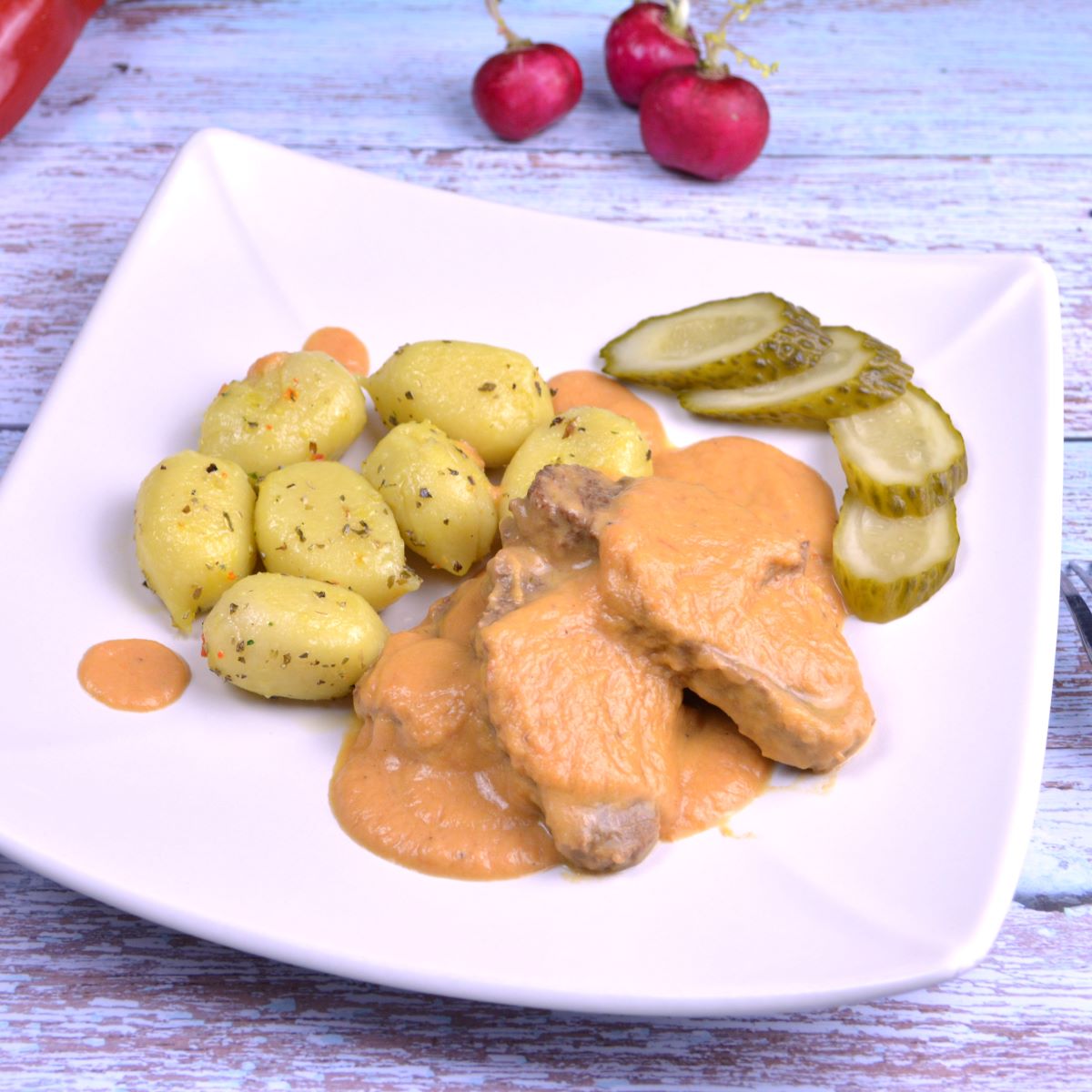
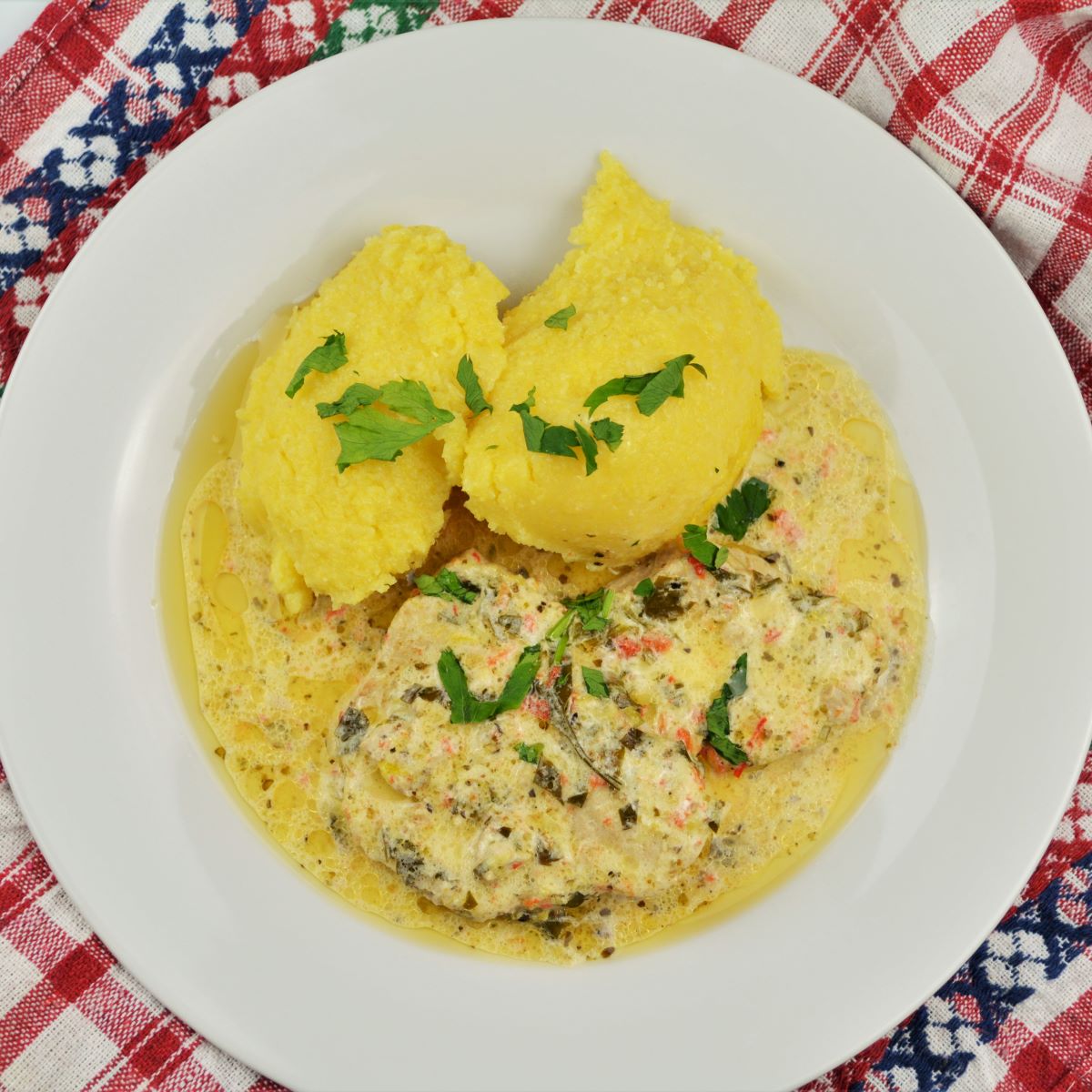






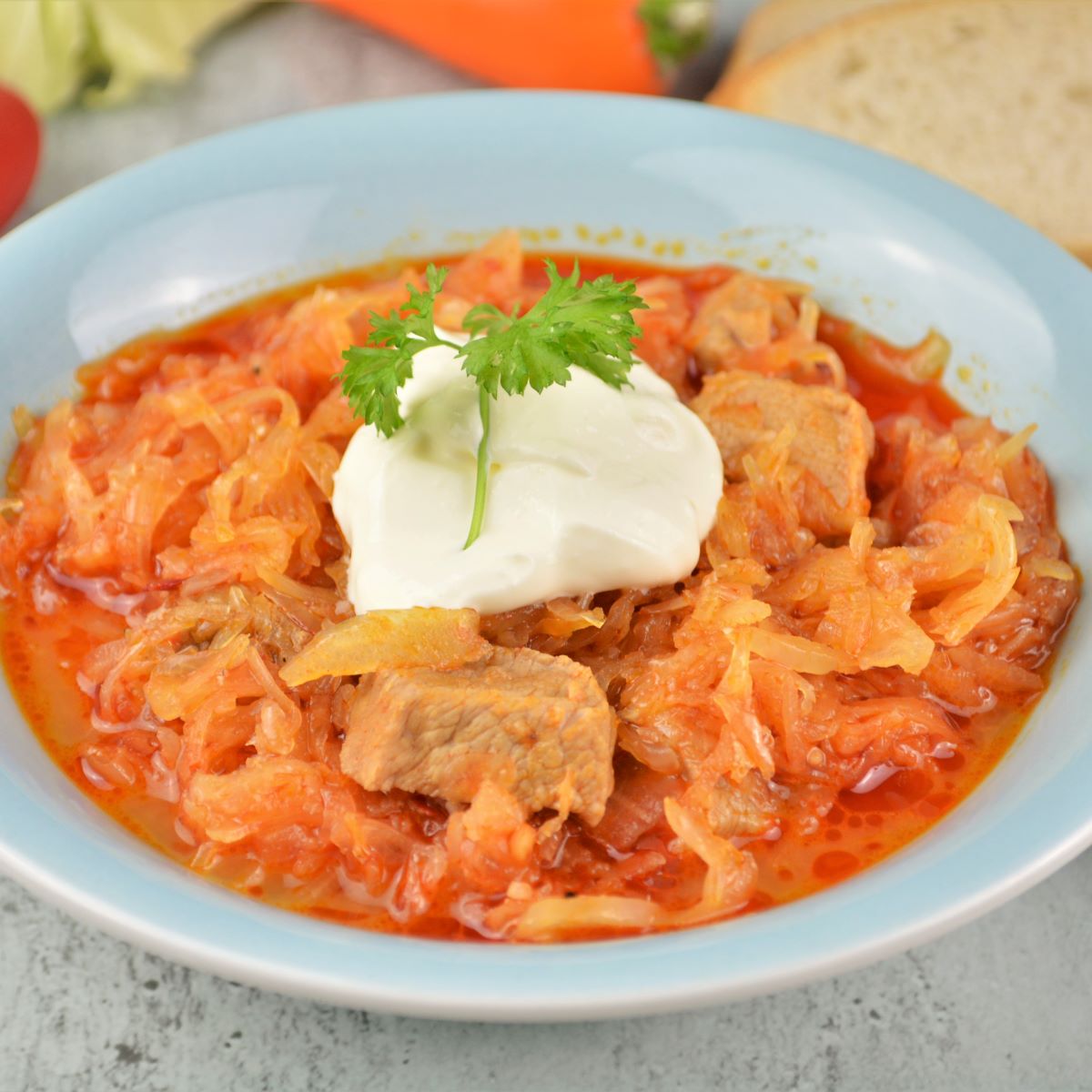
Leave a Reply